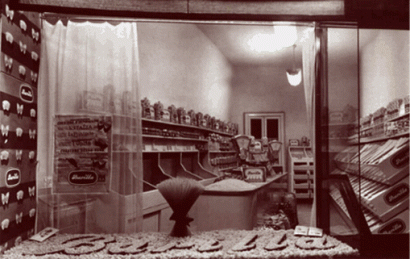Advertisement at the sales points

During the first years of the century and in the period between the two wars, commercial communication was a sort of challenge for a food company. The Barilla company, founded by Pietro Senior in 1877 with an oven located in Strada San Michele, and expanded starting from 1911 with the factory located just outside the city walls in Viale Veneto under the guidance of his sons Gualtiero and Riccardo, accepted this challenge.
The advertising solutions that were adopted at the time – in a context very different than that of our modern day – were particularly interesting, and even in our era of satellite communication, it is worthwhile to tell this story made of limited means and of great imagination.
Back then, there was a crucial point to overcome: pasta, as many other different products, was sold in bulk. How could it be possible to make a brand recognizable and easy to remember in the absence of packaging?
These were exactly the terms of the challenge. Evidently, the solution was in the sales points. In those times, stores were considered to be mono brand, since they sold exclusively one brand of pasta. To achieve a commercial result it was essential to win the trust of the sales points; to obtain a result in communication, it was necessary to engage the store as the main supporter of the brand, and the store keeper as the main recipient of the advertising message.
Therefore, the “dressing up” of the sales point became a crucial issue in communication. In a mono brand store, the brand played out the largest part of its chances: if the store sold Barilla pasta, this had to stand out in terms of advertisement. In turn, the sales point reflected the message of the brand to its clients: this is the reason why we find a true system of merchandising at work, first addressed to the owner of the store and in second instance to the clients, who benefited from the promotions of the Company through the store.
The list of advertising means is surprisingly long and varied and includes wall calendars, small pocket calendars, note pads, pencils and pencil sharpeners, price tags, catalogs, small makeup mirrors for ladies and large mirrors for the stores, three-dimensional logos, signs, and postcards.
The thread that connected this remarkable array was the brand logo, that in the history of Barilla was for many years the very famous one of the shop apprentice pouring an egg, and that starting from 1926 was juxtaposed to the character of the “Flying Chef”. The first logo, registered in 1910, was still included in the norms of the Trademark and Business Law of the times that required the logo to be a “speaking” element: that means it had to be explicit and self evident without need of wording. This law provision was made necessary by the high number of illiterate population in Italy. Today we could observe that the Barilla logo was not only a “speaking” one, but already an advertising model, since it placed emphasis on the distinctive element of the egg in memorable ways, that, through the transformations that followed in time, still remains at the base of the Company brand logo.